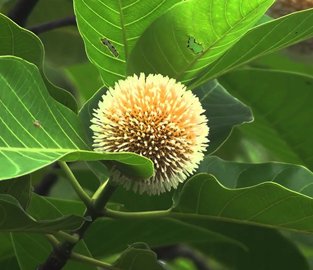Contact Us : +91-9354084237 contact@ranthamboretigereserve.in
Contact Us : +91-9354084237 contact@ranthamboretigereserve.in
Ranthambore National Park, nestled on the edge of the Aravalli and Vindhya ranges, is known for its enchanting natural beauty, amplified by a rich diversity of flora that brings the landscape to life. The park's vegetation is primarily dry deciduous, thriving in semi-arid conditions with rocky hills, scrublands, and perennial lakes. The resilient Dhok tree (Anogeissus pendula) stands out as the predominant species, covering approximately 75% of the park's woodland. This native tree flourishes on hill slopes and plays a vital role in supporting the park’s herbivores like deer and antelope, thanks to its dense foliage and nutritious leaves. Sacred and stately trees such as Banyan (Ficus bengalensis) and Pipal (Ficus religiosa) are common throughout the landscape, offering shade and shelter to various animal and bird species. Near the Jogi Mahal lies one of the largest Banyan trees in India, a living marvel of nature. Trees such as Mango, Neem, Tamarind, Ber, and Jamun are found throughout the park and are known not only for their ecological and medicinal value but also for attracting diverse fauna with their seasonal fruits. During spring, trees like Flame of the Forest (Butea monosperma) burst into brilliant bloom, setting the forest alight with fiery hues.
In addition to these trees, the park nurtures a wide variety of shrubs and undergrowth, creating a complex and layered ecosystem. Trees like Babul, Gurjan, Kadam, Khair, Kikar, Mahua, Salar, and Tendu add richness and color to the landscape. These trees, many of which are source materials for herbal medicine, natural dyes, and even local treats like Mahua fruit liquor, support both wildlife and human communities nearby. Tendu leaves are mostly used to roll traditional Indian bidis, while Khair tree extracts are used to make paan. Aquatic flora such as lotus, water lilies, and khus grass add tranquility to lakes and water bodies, which are vital lifelines for the park’s animals. This diverse blend of trees and wetland plants not only enhances Ranthambore’s scenic beauty but also plays an essential role in conserving water and maintaining soil health, making the park a botanical treasure trove set against rugged earth.

Ranthambore’s animal kingdom is equally mesmerizing, making it one of India’s premier destinations for wildlife enthusiasts. The park's star attraction is undoubtedly the majestic Royal Bengal Tiger, which roams freely across open grasslands, dense forests, and rocky outcrops. Unlike in many other tiger reserves, tigers here are known for their daylight sightings, offering visitors a thrilling chance to witness this apex predator in its natural habitat. Apart from the tiger, Ranthambore is home to several other feline species including the elusive Leopard, Caracal, Jungle Cat, Fishing Cat, and Leopard Cat. These secretive predators add a layer of mystery to the wilderness and play a crucial role in balancing the food chain. The park is also inhabited by Sloth Bears, Striped Hyenas, Desert Foxes, Indian Palm Civets, Jackals, and Mongooses, each contributing to the rich diversity of carnivores found here.
The herbivore population in Ranthambore is equally abundant, featuring graceful Spotted Deer (Chital), large and majestic Sambar Deer, swift Indian Gazelles (Chinkara), and robust Nilgai (Bluebull), among others. These animals can often be spotted grazing quietly in open clearings or near water bodies, forming picturesque scenes against a backdrop of ancient ruins and forested hills. The park's wetland areas are ideal habitats for Marsh Crocodiles and Indian Pythons, which thrive amid its numerous lakes and streams. Ranthambore is also a paradise for bird watchers, boasting over 300 bird species including Kingfishers, Painted Spurfowls, Sarus Cranes, Crested Serpent Eagles, Vultures, and the elusive Great Horned Owl. With its expansive biodiversity and enchanting mix of forest, grassland, and water ecosystems, Ranthambore offers a living symphony of sights and sounds where every visit feels like stepping into a real-life jungle story.